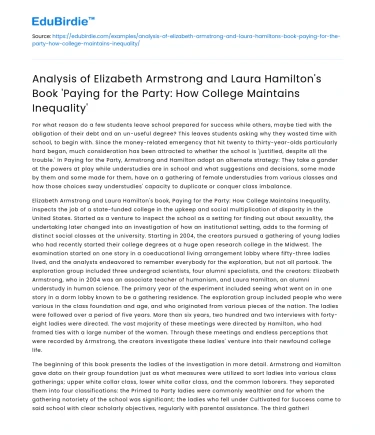For what reason do a few students leave school prepared for success while others, maybe tied with the obligation of their debt and an un-useful degree? This leaves students asking why they wasted time with school, to begin with. Since the money-related emergency that hit twenty to thirty-year-olds particularly hard began, much consideration has been attracted to whether the school is 'justified, despite all the trouble.' In Paying for the Party, Armstrong and Hamilton adopt an alternate strategy: They take a gander at the powers at play while understudies are in school and what suggestions and decisions, some made by them and some made for them, have on a gathering of female understudies from various classes and how those choices sway understudies' capacity to duplicate or conquer class imbalance.
Elizabeth Armstrong and Laura Hamilton's book, Paying for the Party: How College Maintains Inequality, inspects the job of a state-funded college in the upkeep and social multiplication of disparity in the United States. Started as a venture to inspect the school as a setting for finding out about sexuality, the undertaking later changed into an investigation of how an institutional setting, adds to the forming of distinct social classes at the university. Starting in 2004, the creators pursued a gathering of young ladies who had recently started their college degrees at a huge open research college in the Midwest. The examination started on one story in a coeducational living arrangement lobby where fifty-three ladies lived, and the analysts endeavored to remember everybody for the exploration, but not all partook. The exploration group included three undergrad scientists, four alumni specialists, and the creators: Elizabeth Armstrong, who in 2004 was an associate teacher of humanism, and Laura Hamilton, an alumni understudy in human science. The primary year of the experiment included seeing what went on in one story in a dorm lobby known to be a gathering residence. The exploration group included people who were various in the class foundation and age, and who originated from various pieces of the nation. The ladies were followed over a period of five years. More than six years, two hundred and two interviews with forty-eight ladies were directed. The vast majority of these meetings were directed by Hamilton, who had framed ties with a large number of the women. Through these meetings and endless perceptions that were recorded by Armstrong, the creators investigate these ladies' venture into their newfound college life.
Save your time!
We can take care of your essay
- Proper editing and formatting
- Free revision, title page, and bibliography
- Flexible prices and money-back guarantee
The beginning of this book presents the ladies of the investigation in more detail. Armstrong and Hamilton gave data on their group foundation just as what measures were utilized to sort ladies into various class gatherings; upper white collar class, lower white collar class, and the common laborers. They separated them into four classifications: the Primed to Party ladies were commonly wealthier and for whom the gathering notoriety of the school was significant; the ladies who fell under Cultivated for Success came to said school with clear scholarly objectives, regularly with parental assistance. The third gathering called Motivated for Mobility involved lower white collar class or common laborers understudies from provincial, at times rural territories who accepted that an advanced degree would furnish them with upward social versatility. This class structure can be seen at any school but I have noticed this a the University of Delaware. Each class structure discussed in this book can be seen throughout campus. I can attach the girls in the most popular sororities to the “Primed to Party” women. The majority of these girls here are the typical skinny, physically attractive girls who most likely have come from a past of more than average wealth. These girls are the epitome of the party scene here at the University of Delaware. They are selective in whom they want to be a part of their sorority in fear the choosing of the wrong people may tarnish the perfect reputation they crave to uphold.
Another aspect of this book is the forming situation. In residence life, the school discussed in the book enabled its students to self-select into residences. Everybody is required to live on grounds first year, with a couple of exclusions including wedded, more established, and low-maintenance undergraduate students. Unavoidably, the rich understudies with family associations and social skills overwhelm the dormitories with the gathering notorieties, leaving the less favored understudies who simply ended up there very detached and inclined to get lost in an outright flood. The University of Delaware, similar to the school discussed in the book, requires its freshman undergraduate students to live on campus during their first year. At the University of Delaware, we did not have the option to choose what dorm we lived in, unlike MU. By having the opportunity to choose where they live, most freshmen would probably choose to live in a dorm notorious for partying such as some domortoties on our campus. The book closes with a chapter that provides recommendations for higher education policy. In conclusion, this book suggests genuine conversation starters about the eventual fate of advanced education in the United States. Advanced education should give way to social portability for all who wish for that. This investigation finds that for some understudies, this isn't the situation. This is bolstered by other late work which shows that young students' possibilities of acquiring more than their folks have tumbled. Amidst expanding financial imbalance in US society, this book puts stress on the sorts of lives and life directions looked at by possible college students in the United States.






 Stuck on your essay?
Stuck on your essay?

